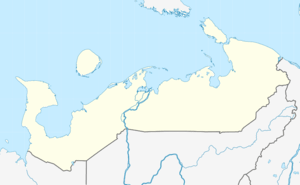Vaygach Island
| Native name: Вайга́ч | |
|---|---|
 Vaygach Island and Novaya Zemlya | |
 Vaygach Vaygach Island, Nenets Autonomous Okrug (Russia) | |
| Geography | |
| Location | Arctic Sea |
| Coordinates | 69°59′49″N 59°34′44″E / 69.99694°N 59.57889°ECoordinates: 69°59′49″N 59°34′44″E / 69.99694°N 59.57889°E |
| Area | 3,383 km2 (1,306 sq mi) |
| Length | 100 km (60 mi) |
| Width | 45 km (28 mi) |
| Highest elevation | 170 m (560 ft) |
| Highest point | Gora Bolvanskaya |
| Administration | |
|
Russia | |
| Oblast | Arkhangelsk Oblast |
| Okrug | Nenets Autonomous Okrug |
Vaygach Island (Russian: Вайга́ч, Vajgač) is an island in the Arctic Sea between the Pechora Sea and the Kara Sea.
Vaygach Island is separated from the Yugorsky Peninsula in the mainland by the Yugorsky Strait and from Novaya Zemlya by the Kara Strait. The island is a part of Nenets Autonomous Okrug of Arkhangelsk Oblast, Russia.
- Area: 3,383 square kilometres (1,306 sq mi)
- Length: ~ 100 kilometres (62 mi)
- Width: up to 45 kilometres (28 mi)
- Average temperatures: −20 °C (−4 °F) (February), 5 °C (41 °F) (June)
- Highest point: 170 metres (560 ft)
Vaygach Island is mainly formed of argillaceous slates, sandstone, and limestone. There are many rivers about 20–40 kilometres (12–25 mi) in length, swamps, and small lakes on the island. For the most part it consists of tundra. Slight rocky ridges run generally along its length, and the coast has low cliffs in places. The island consists mostly of limestone, and its elevation above the sea is geologically recent. Raised beaches are frequent. The rocks are heavily scored by ice, but this was probably marine ice, not that of glaciers. The settlements of Vaygach, Dolgaya Guba, and Varnek are located on the island.
Fauna and flora
Grasses, mosses and Arctic flowering plants are abundant, but there are no trees excepting occasional dwarf willows. Foxes and lemmings are spotted occasionally. While there are not many land animals on the island, birds are very numerous; a variety of ducks, waders etc. frequent the marshes and lakes. At least five polar bears are known to inhabit the island.
Nature reserve
In 2007, the World Wide Fund for Nature (WWF) and the Russian government have approved a nature reserve on Vaygach island.[1] The island's surrounding seas are home to many marine mammals such as walruses, seals and endangered whales.
Ethnography
The name of the island translates from the Nenets as "alluvial shore". Until the 19th century, the island was an important shrine of the Nenets people. There were polycephalic wooden idols painted with blood of holy animals, primarily reindeer. Some of their sacrificial piles, consisting of drift-wood, deer's horns and the skulls of bears and deer, have been observed by travellers. In spite of their conversion to Christianity, the Nenets still regard these piles with superstition.
See also
Notes
- ↑ "New Nature Reserve For The Russian Arctic". ScienceDaily. World Wildlife Fund. 2007-07-06. Retrieved 2008-04-29.
References
-
 This article incorporates text from a publication now in the public domain: Chisholm, Hugh, ed. (1911). "Vaygach". Encyclopædia Britannica (11th ed.). Cambridge University Press.
This article incorporates text from a publication now in the public domain: Chisholm, Hugh, ed. (1911). "Vaygach". Encyclopædia Britannica (11th ed.). Cambridge University Press.
Further reading
- F. G. Jackson. Great Frozen Land. London, 1895.
- H. J. Pearson. Beyond Petsora Eastward. London, 1899.
- Vaigach - The 'Easter Island of the Arctic'